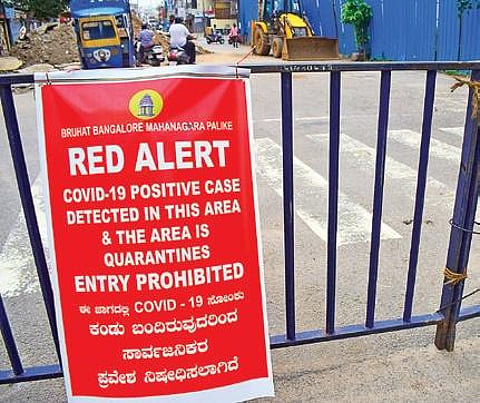

BENGALURU: It’s shocking. Bengaluru now has 16,005 containment zones from a mere 20 in May, as the city has been reporting nearly 2,000 Covid-positive cases daily over the last few days. Of these, 12,325 are active containment zones. The South Zone leads the list with 3,935 containment zones, followed by East with 2,256, West 1,770, Bommanhalli 1,548 and Yelahanka 437. In all, 13,276 streets, 1,267 apartment complexes, 23 slums, 40 clusters and one hotel have been identified as restricted areas as on Monday, according to the BBMP Covid-19 war room data.
While BBMP officials blamed people for not taking enough precautions after the lockdown was eased, leading to the spike, experts said the state government and Palike should stop pointing fingers at people, and focus on carrying out a comprehensive survey of Severe Acute Respiratory Infection and Influenza Like Illness cases, and reverse isolation of the elderly and comorbid patients.
Dr Giridhar Babu, Professor and Head, Lifecourse Epidemiology, PHFI and a member of the Covid expert committee, said, “The SARI and ILI survey should be conducted at least once in 10 days, along with enhanced testing, strict isolation of cases and reverse quarantining. This will reduce transmission and also the burden on hospitals. We can also save lives with this strategy.”
Dr Sylvia Karpagam, a public health expert and researcher, said the containment strategy works only in initial stages and the focus should have been on reverse quarantine. “Effective measures were not carried out by the government and BBMP. Containment is a planned strategy during the initial stages of a pandemic to cordon off areas that have reported a peak in cases and allows the spread to be curbed. However, when several areas are affected, containment is not a good strategy. If the government acknowledges community spread, then the focus can move from containment to two things -- one, to prevent the spread from person to person, and the other to protect high-risk groups,” she said.
“If everyone is assumed to be potentially infected then everyone is encouraged to take universal precautions. But continuing with containment creates a feeling that some places are at risk and others are not. But in reality, all areas are at potential risk. With cases and deaths rising in Bengaluru, the focus should be on setting up safe reverse quarantine facilities for those at high risk, and publicise this,” she added.
Despite containment, all areas at risk: Expert
But BBMP officials said that they have been monitoring cases effectively. “Our field officers are doing a good job. It takes time to locate positive people as exact addresses are not shared. Otherwise, barricading is done on the same day or the next day,” said Basavaraj, a nodal officer, BBMP, who is in charge of containment zones.
Marshals and police have been put on the job to ensure that rules are not violated. Citizens under home quarantine and primary and secondary contacts are stamped, another senior BBMP official said.But many residents within containment zones complained that they cannot move around as areas are sealed and said only a positive person should be quarantined and not entire roads. Also, they are finding it difficult to find food, the residents said. “There has been a problem because of the rise in cases. It will be looked into and sorted out soon,” a BBMP officer said. Some officials said that the city has too many committees and officers are changed midway, leading to confusion.